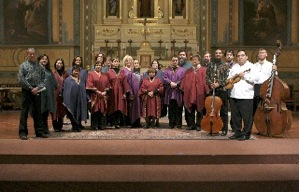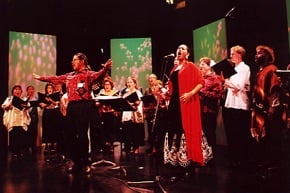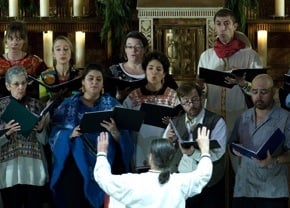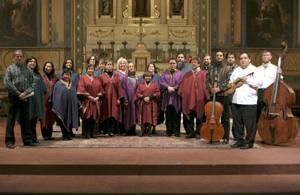
Related Articles
Alondra de la Parra: Building New Audiences for Classical Music
July 12, 2010
Mexico’s Sizzling, Sensual Soul
July 20, 2010
Gabriela Lena Frank: The Well-Grounded Composer
April 27, 2010
Martha Rodríguez-Salazar, a classically trained flutist and singer from Mexico City, discovered a rich new world of music after moving to San Francisco a dozen years ago.
"I learned more about Mexican music here than I did in Mexico,” says Rodríguez-Salazar, who teaches at the San Francisco Community Music Center, where she also leads the Latin Music Vocal Workshop. She was exposed to a vast range of Mexican music — Renaissance and Baroque compositions, 19th-century rancheras, the folkloric music of Veracruz and other regions — while working with Coro Hispano de San Francisco. That’s the celebrated community-based ensemble that specializes in the vocal music of Latin America, Spain, and Portugal.
Founded in 1975, Coro Hispano, which sings liturgical and secular music spanning five centuries, is one of several primo ensembles on the Bay Area’s vital Mexican music scene. Another, Los Cenzontles, an octet associated with San Pablo’s Los Cenzontles Mexican Art Center, helped revive Mexican roots music in California, playing authentic folk music from Jalisco (the birthplace of mariachi), Michoacán, and Veracruz, as well as creating its own contemporary Chicano music. And Oakland’s Cascada de Flores interprets traditional Mexican and Cuban music.
Then there are popular local bands, like La Familia Peña-Govea, led by multi-instrumentalist Miguel Govea, which plays its own mix of mariachi and norteño, the joyous, accordion-based music whose waltz and polka rhythms came from the Germans and Czechs who immigrated to northern Mexico and the southwestern United States in the mid-1800s. Walking through San Francisco’s Mission District, you might come across a Tex-Mex band, or conjunto, playing on the street, or hear a guitar-playing singer performing corridos, the narrative ballads that became hugely popular during the Mexican Revolution, which began 100 years ago on November 20.
Research and Outreach: Coro Hispano
“It’s a very rich scene for Mexican music here,” says Rodriguez-Salazar, who directed the Community Music Center’s big Mexican Christmas musical, La posarela, at the Victoria Theatre on Sunday afternoon. She also serves as a consultant for the San Francisco Symphony’s annual Día de Los Muertos bash, which last month honored the centenary of the Mexican Revolution.
The orchestra played music by Silvestre Revueltas, José Pablo Moncayo, and other Mexican composers, reprising some of the pieces it performed under the baton of the gifted young Mexico City–bred conductor Alondra de la Parra in Dolores Park in July, when the Symphony toasted the bicentennial of Mexican independence. The preconcert Day of the Dead festivities included performances by the Peña-Govea band and Oakland’s Mariachi Colima.
Listen To The Music
Coro Hispano - Los PastoresFor a number of years, Rodriguez-Salazar was the assistant conductor of Coro Hispano. She helped the group’s indefatigable founder and artistic director, Juan Pedro Gaffney — a Mission District–bred Irish-American who embraced Latin culture and music — research and transcribe 16th-, 17th-, and 18th-century manuscripts and choir books from the archives of the Puebla Cathedral in Mexico.

Coro Hispano and its instrumental group, Conjunto Nuevo Mundo, will perform some of that music at its 24th annual Día de Los Reyes (Three Kings Day) concert Jan. 9 at Mission Dolores Basilica in San Francisco.
The other night, Gaffney was rehearsing the sopranos and contraltos in the Sanchez Elementary School auditorium. They worked over the polyphonic Albricias, Pastores (loosely translated as “A Tip, Shepherds”). It’s a nativity villancico — an Iberian poetic and musical form — composed in 1653 by Juan Gutierrez de Padilla, the chapel master at Puebla Cathedral. Gaffney, a charming chap with a graying ponytail and white moustache, plunked chords at an old upright piano and demonstrated phrases by singing them in a pitch-perfect falsetto.
“Give that last note its full value, with strength,” Gaffney told the singers in Spanish. Herminia Albarrán Romero nodded, singing the phrase again with gusto.
A noted papel picado (cut paper) artist who creates paper flowers and traditional altar arrangements, Romero has sung with the Coro since 1998. She came to San Francisco in 1981 from Cuernavaca, where she grew up singing rancheras, corridos, and boleros.
“I love to sing,” said Romero, whose splendid altar creations have been displayed at the Oakland Museum and at the Symphony’s Día de Los Muertos shows.
Gaffney: DIY Latino

In addition to performing 16th-century works like Dios Itlanconantzine, written in the Nahuatl language by an Aztec given the Spanish name Hernán Franco, Coro Hispano also sings Gaffney’s arrangements of popular Mexican songs like El Tilingo-Lingo, a classic son jarocho from Veracruz. That’s the percussive, improvisational style in which the instrumentalists play off the stamping rhythms of the dancers, and the vocalists can sing hundreds of different verses. (La Bamba is a classic example.)
“We sing music written in the 15th century and as late as yesterday,” said Gaffney, whose group has performed and recorded José Luis Orozsco’s contemporary Corrido de César Chávez, and occasionally sings the beloved 1882 ranchera Cielito Lindo. “Everybody has that tune in their heads,” said Gaffney. “We turn it into a sing-along. We let the gringos get into the act,” he added with a laugh.
Gaffney is a self-made Latino who learned Spanish so he could communicate with the Mexican kids moving into the Mission District, then a blue-collar Irish neighborhood, in the 1950s. He fell in love with Mexican music listening to the mariachis at La Rondalla — the venerable but now shuttered restaurant and cantina on Valencia Street where the Christmas lights never came down — and to the traditional trios and conjuntos he’d hear around the ’hood.
Living in Venezuela, Gaffney was dazzled by the complexity and richness of the folk and classical music there. After getting a bachelor’s degree in music at UC Berkeley, and then a master’s in vocal music and choral conducting at Stanford University, he started Coro Hispano, a mix of dedicated amateurs and professional “ringers.”
“I wanted to create an ensemble of singers and instrumentalists, drawn largely from the Spanish-speaking communities of the Bay Area, dedicated to performing the music of the Hispanic world, with a certain emphasis on Mexico,” Gaffney said.
Listen To The Music
Familia Peña-Govea: Los laureles (excerpt)Miguel Govea, a Chicano from Bakersfield who moved here in 1978 to attend UC Berkeley, said Gaffney “is more Mexican than a lot of Mexican-Americans.” A stalwart on the Bay Area Latin scene for a quarter century, Govea plays trumpet, button accordion, and guittaron, the big bass guitar, in two choice bands: the more traditional Familia Peña-Govea, which features his wife and two daughters, and Los Compas, which plays all kinds of Latin music.
The family band will back Tex-Mex accordionist Santiago Jimenez Jr. (brother of multiple Grammy Award-winner Flaco Jimenez) Feb. 4 at Freight & Salvage in Berkeley. The performance is part of the three-day 50th birthday celebration for El Cerrito’s Arhoolie Records, the prized roots-music repository, whose foundation contains an invaluable archive of Mexican and Mexican-American recordings.
Reconnection and Revival: Los Cenzontles and the Old Mariachi Style
The Arhoolie bash also features Los Cenzontles playing with stars Ry Cooder and Taj Mahal. The group’s founder, Eugene Rodriguez, will also appear on a panel about Mexican music with singer Linda Ronstadt, who served as artistic director for San Jose’s huge Mariachi and Mexican Heritage Festival in 2009. The performers that year included Latin rock legend Carlos Santana, the Jalisco-born musician whose late father, the noted mariachi violinist José Santana, worked out of the Mariachi Club on Mission Street in the late 1950s.
Featured Video
Rodriquez started Los Cenzontles (“The Mockingbirds,” in Nahuatl) in 1989 after earning a master’s degree in guitar from the San Francisco Conservatory of Music, where he studied with David Tanenbaum. He wanted to reconnect with music he’d played with his family as a kid in Glendale. A fourth generation Mexican-American, Rodriquez missed that “feeling of connectedness,” of making music in a social setting.
“I really wanted to learn about Mexican folk music. What I was hearing on records and radio was mostly commercialized, watered down, and cheesy,” he said. He flipped when he heard a group of Veracruz musicians playing the “real deal.” “It was like living Baroque music. It had instruments improvising around rhythmic patterns people dance to. The harmonies were simpler than those of Bach, but the idea was the same. That just thrilled me. I wanted to learn it, and play and teach it.”
Rodriguez, whose ensemble plays traditional instruments like the jarana, an eight-string guitar of varying size, and the quijada, a donkey jawbone used for percussion, created a kind of exchange program with these Mexican musicians. He brought them to the Bay Area to perform, and took a group of kids from the Mexican Arts Center to Veracruz. He later discovered an elderly violin player from Jalisco, Julian Gonzales, who played a string-band style of mariachi that predated the trumpet-rich orchestras. At the time, Gonzales was working as dishwasher in Belmont.
He taught the young American musicians the old mariachi style, “which we pretty much resurrected,” said Rodriguez, whose ensemble recorded a series of albums with Gonzales. In 2005, they accompanied him back to Jalisco, where Passajero: A Journey of Time and Memory, a documentary about Gonzales that aired on PBS, was filmed.
Making the Scene: The 1930s to Now
According to the Latin music historian Jesse Varela, Mexican music in the Bay Area started cooking in the 1930s with the arrival of Merced Gallegos, a classical bassist trained at the conservatory in Guadalajara. He formed a dance band that played boleros and danzones and the popular Mexican music of the period at places like the Sailors of the Pacific Union Hall (now the Maritime Hall).
“The scene busted open during World War II, when all these people migrated to San Francisco and Oakland, and began their own bands, playing mambo and Mexican music,” Varela said. “Then more and more mariachis started coming in, particularly to San Jose, where they would congregate at the Mercado, which became the San José flea market. To this day, the flea market has mariachis on Sunday.”
Hector Armienta, a San Jose–based composer of chamber opera, musical theater, and orchestral pieces, often draws on Mexican and Tejano idioms in his music. A second-generation Mexican-American from Los Angeles, he studied composition with Conrad Susa at the San Francisco Conservatory, where he received his master’s degree.
“My music reflects a bicultural musical perspective, as well as 20th- and 21st-century influences,” said Armienta, whose Caras del Sol (Faces of the sun), commissioned by the Pacific Symphony in Costa Mesa, incorporates elements of mariachi music. In May, the Oakland Youth Orchestra, eager to reach out to the Bay Area’s large Latino population, will perform Postcards From Mexico, a three-part work that Maestro Michael Morgan commissioned from Armienta.
The first movement, “La Llorona,” inspired by the Mexican myth of the Weeping Woman who drowns her children, quotes and transforms the famous corrido of the same name. “Jalisco,” the second movement, casts mariachi melodies in a whole-tone scale.
“You hear the flavor of mariachi, but it’s not mariachi,” said Armienta, whose final movement, “Jarocho,” revels in the stamping rhythms of Veracruz. “Sometimes when I’m asked to write a piece, I have to make it clear that I’m not going to write a folk piece, but a piece that represents who I am as an American composer of Mexican ancestry.”
Not a problem in the city of Saint Francis.

